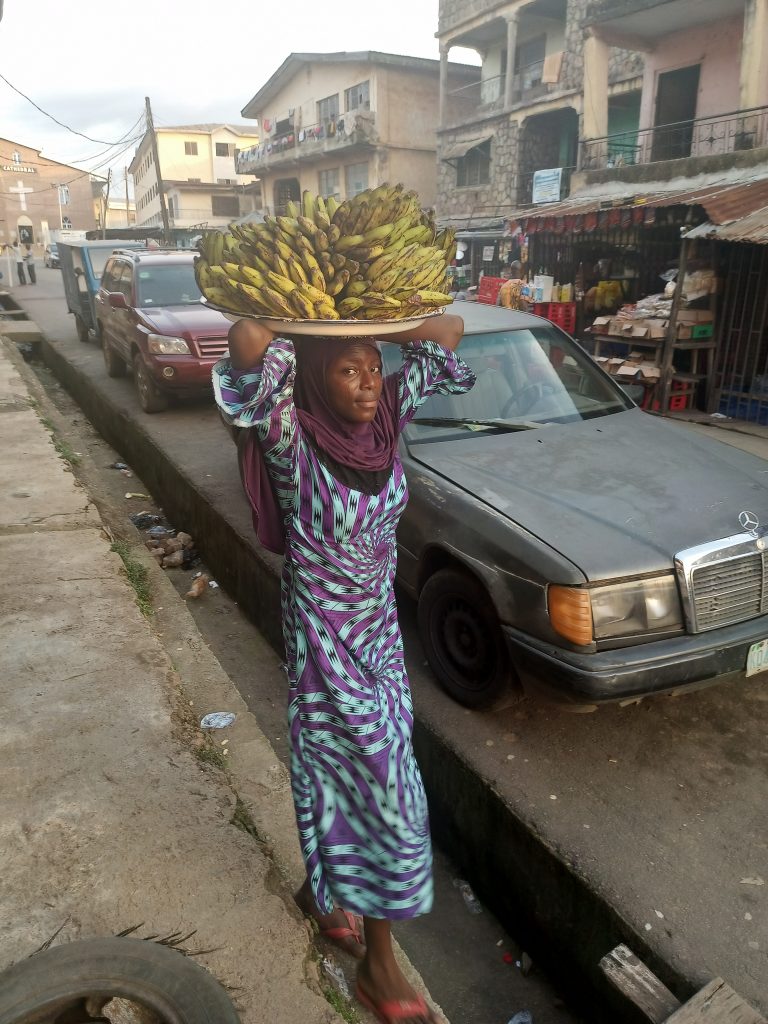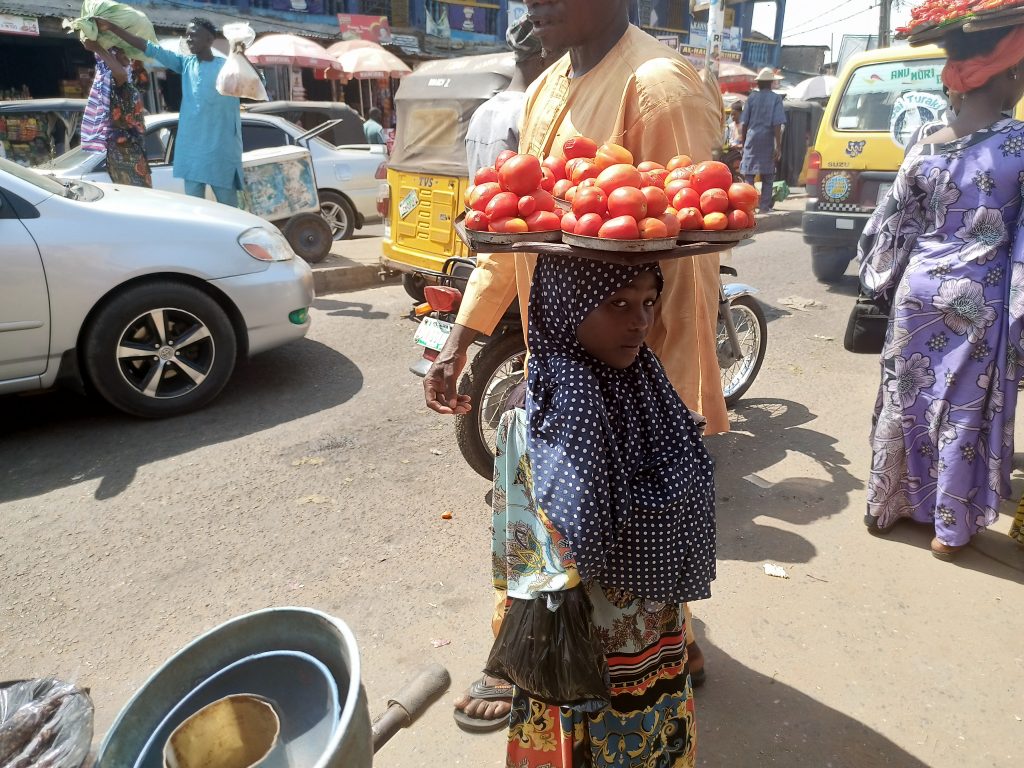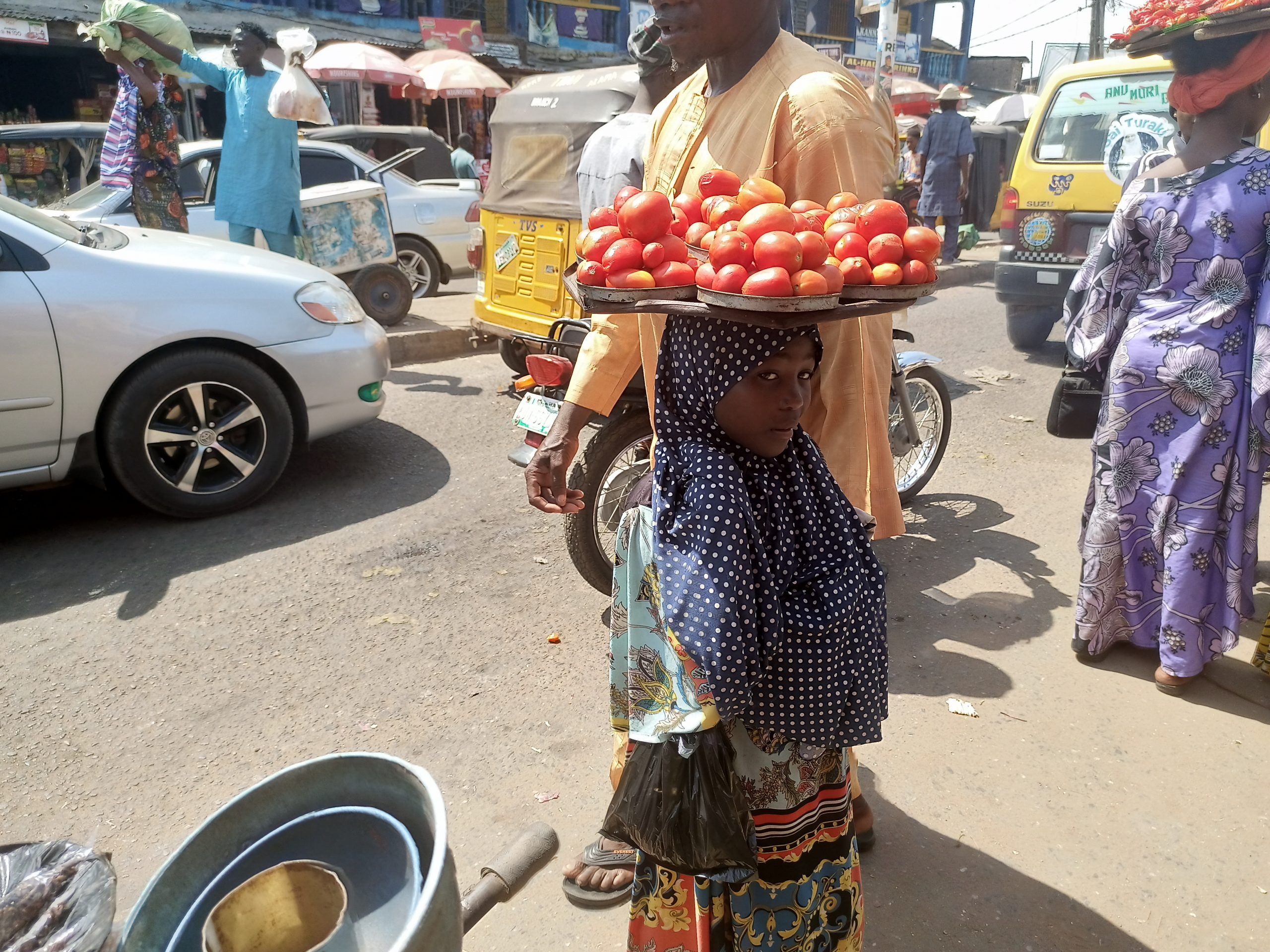By Dare Akogun
While their mates are in classrooms studying, thousands of minor’s hawk and wade through traffic and motor parks endangering their lives in the process and portraying our decadent social order, DARE AKOGUN met some of these disadvantaged children and he reports.
They look fragile, rough and weather beaten as they struggle with the burden of their wares even as they wade through the slow traffic at Oja Oba and Ipata markets in the heart of the Ilorin Metropolis. Their ages range between nine and early teens with the eldest among them mostly in their mid teens.
They are kid hawkers and they dot the nooks and crannies of the country, especially the cities. They are out on the streets daily, while their mates are in school getting to terms with words and figures. This is the world of kid hawkers in Kwara, looking rough, uncertain and driven by the desire to survive. The woes of these children go beyond the hardship of meeting their daily sales target.
The female ones most especially encounter men who try to take advantage of them by having canal knowledge of them or resort to raping those who reject their advances. They are also faced with threats from ritual killers, kidnappers and men of the underworld.
Our reporter encountered some of these kids recently in Ilorin Kwara state capital. They were four girls hawking banana, smoked fish and Wara (Cheese) at Ipata area of Kwara State.
They were shy and reluctant to speak when asked if any man had made sexual advances to them in the course of their business. But after assuring them that their photographs would not be taken, one of them named Sakirat, nudged another known as Fatima to narrate her experience about a month ago. Sakirat, a 16-year-old pupil of a secondary school in Pakata area of Ilorin, said she lost all her wares to a man who wanted to rape her beside a motor park at Amilegbe.
“The man called me to bring the bananas I was selling. It was around 7pm.
“Some other people were there with him. When I went to meet him in the front of the house where he was standing, he told me to come to the back of the house where he kept the money. When we got there, he grabbed me and tried to pull down my pants. But I dropped all my bananas and ran away,” she narrated.

Sakirat added that she later went to the place with her mother that evening but never saw the man again, and all her wares were gone.
Another child street trader, Aishat, had a similar experience when a young man, one of her regular customers, inflicted an injury on her wrist while trying to have his way with her. The girl, who said she was 15, had aged beyond her years as a result of being exposed to life on the streets.
She said, “The name of the boy was Ayinde, he was touching me and telling me I was not a small girl. He wanted to close the door of the shop where he was working in Ago market when I went to sell Fura & Nunu (local yoghurt) that day. He twisted my arm and hit my wrist against the door.
“He always asked me to come and sell to him every day. I did not sell to him again since that day. I reported him to his boss the following day at the store.” The experiences of Sakirat and Aishat are just two of many faced on the streets of Ilorin by kid hawkers on a daily basis. Rapists are not the only threat these kids face on the streets.
They are easy prey for ritual killers as well. Numerous stories abound of ritual killers and kidnappers taking underage children from the clutches of their loved ones to carry out their nefarious activities.
Nine-year-old Sherifat Ayinla, who sells tomatoes and pepper after school hours, said she once witnessed the arrest of a man who, moments before then, had offered her and her friends’ chocolates around Mubo area also in Ilorin.
“The man told us he wanted to buy tomatoes and brought out the chocolate. He gave it to me and said he did not want it to waste because he had many. I refused it and told two of my friends who were with me at the time not to accept it as well.
“A woman suddenly grabbed the man and shouted that he was a kidnapper. She said he was trying to kidnap some boys in another street, so they trailed him to Maraba.
When they searched his pocket, they found chocolates and some hairs wrapped in different nylons. They beat him and took him to the police station,” Ayinla said.

At the gate of a night club, in Coca Cola Road area of Ilorin stood a minor, Benjamin Akaso, at around 8.30pm on a Thursday, he had a tray of popcorn on his head. Passing by, the boy said plaintively, “Oga, buy popcorn.” The desperation was obvious in his voice. His full tray showed he could only have sold a few wraps of the popcorn.
The popcorn was packaged in small nylon packs of N50 each. “What are you doing selling pop corn at this time of the day?” I probed him; his answer was a testimony to the plight of child street traders.
“I have only sold five, please, help me to buy. I will go to bed hungry if I don’t sell more,” he lamented.
Many people passed by without paying him any attention. He still had 35 packs left, which meant he still had N1750 to make before retiring for the night.
Position of the Law
The National Human Rights Commission notes that the primary purpose of government is the security and welfare of its citizens in line with Section 14(2) (b) of the Constitution of the Federal Republic of Nigeria 1999.
Conscious of its mandate to monitor, promote, protect and enforce human rights of everyone in Nigeria in line with the national, regional, and international human rights instruments to which Nigeria is a party, the Commission has always spoken against the inhuman condition’s children are subjected to under any guise.
Nigeria has ratified and is a party to the Convention on the Rights of the Child (CRC), African Charter on the Rights and Welfare of the Child (ACRWC) and the African Charter on Human and Peoples’ Rights which has been domesticated as Child’s Rights Act (CRA) 2003.
The Child Rights Act is a comprehensive human rights instrument that seeks to protect the rights of children in Nigeria and to put in place policies and programs for the development and survival of every child in Nigeria.
Section 4 of Child Rights Act specifically emphasized that every child shall have a right to survival, development, and education. Section 9 provides for freedom of child movement subject to parental control, not harmful to the child.
Other sections provide for rights to private and family life, freedom of movement, freedom from discrimination, the dignity of the child, health and health services, free, compulsory and universal primary education, amongst others.
Also, according to the state Child Rights Law, children are forbidden from engaging in any form of street trading in Kwara State, parents of child hawkers risk prosecution but this has not deterred them from pushing their wards onto the streets to earn a living.
A good question that comes to mind is whether the Kwara State government is still on track in its bid to protect children and accord them their fundamental human rights in the state.
The state’s Attorney General and Commissioner for Justice Barrister Senior Ibrahim Sulyman, said that every child has the right to primary and secondary education, adding that it is the right of the government to provide free education at both primary and secondary level.
He said the Kwara state government took a proactive step by having to have the child act rights law in place which stipulate compulsory universal basic education for children and also prescribes punishment for parents and guardian who refused to enroll their wards in school.
“To improve basic education enrollment, we adopted a template of having conducive environment, retraining the teachers and also initiating the Kwara state trust fund, which is a miniature of TETFUND, where separate funds are set aside to develop the educational sector in the state,” he said.
Barrister Sulyman, added that, as a way of making sure every child has the right to education, the Kwara state government is expanding the educational sector of the state by building of more schools and recruiting more teachers.
The Head of Department Adult and Primary Education, University of Ilorin Dr. Olabisi Adedigba, said in as much as every stakeholder is guilty of the implementation of the Child Rights Acts across the country, there is a lot the government can do in the area of implementation.
According to her “It is a policy and Nigeria is a signatory to it, which is similar to Right to life, Dignity, Protection from exploitation and every form of inhuman treatments. For all these things to work we need to look as education as key to achieving it.

“Almost every state in the country has adopted the Child Right Acts, but what about the real implementation of the policy which encapsulate everything that can prevent the child from gaining access to quality education,” she said.
The University Don who is a Child Rights Advocate and founder of two NGO’s Lampstad Insights and The Royalty Network for Girls and Ladies, maintained that if the law is adequately implemented and anyone that violates the law are made to face the wrath of the law the number of out of school children will greatly reduce in the country.
“By the time we let the law take its course with the right political will, by doing things the way it is supposed to be done everyone will sit up,” she said.
Dr Adedigba who is also the Vice President Early Child Education Association of Nigeria, also added that the government also needs to provide conducive environment for teaching and learning, a situation which she says if it’s done parents and guardians will be encouraged to take their children and wards to school.
“Government should play their role in provision of infrastructure, recruit quality and qualified teachers, provide welfare packages for teachers through increased funding of the education sector in the budgets,” she advised.
Nigeria Has World’s Largest Number of Out-of-School Children – UNESCO
As of October 2022, almost two years later, about 20 million children are out of school in Nigeria, according to the United Nations Educational, Scientific and Cultural Organization (UNESCO). This figure is a far-reaching increase from the 10.5 million recorded by the United Nations Children’s Fund (UNICEF) in 2020.
It said there are 244 million children and youth between the ages of six and 18 worldwide who are still out of school.
According to the statistics, India, Nigeria and Pakistan have the highest figures for out-of-school children globally.
The figure in Nigeria was between 10.5 and 13.5 million. But with insecurity and kidnapping of school children, most parents are not disposed to sending their wards to school.
UNESCO announced the figures in a statement, part of which reads: “The new estimates, published online by the UNESCO Institute for Statistics (UIS) and Global Education Monitoring (GEM) Report, showed that sub-Saharan Africa remains the region with the most children and youths out of school.
“It is also the only region where this number is increasing; out-of-school rates are falling more slowly than the rate at which the school-age population is growing.
“The region with the second highest out-of-school population is Central and Southern Asia with 85 million. The top three countries with the most children and youth excluded from education are: India, Nigeria and Pakistan.”
According to Director of the UNESCO Institute for Statistics, Silvia Montoya, efficient use of available data is important to address the gaps towards achieving the fourth goal of the Sustainable Development Goals (SDGs).
The official said: “UNESCO has long underscored the need to make more efficient use of the data we have. That’s why we’ve brought together administrative data with information from surveys and censuses. By using multiple data sources, gaps are filled, data trends are smoothed, and we can draw consistent time series.”
UNESCO’s Assistant Director General for Education, Stefania Giannini, said: “Global out-of-school numbers are lower than we thought, but far too many children are still missing out. Countries have committed to benchmarks to slash out-of-school numbers by over half by 2030.
We must identify solutions during the Transforming Education Summit called by the United Nations Secretary-General, this September, so that countries can deliver on these pledges. All children should have access to quality education.
It would be recalled that the United Nation Children’s Fund (UNICEF) reported in May 2022 the United Nations Children’s Fund (UNICEF) has said over 10 million Nigerian girls are out of school.
This was disclosed by the Chief of Field Office in Kano, Rahama Farah, during the Media Dialogue on Girls’ Education under the Girls’ Education Project-3 (GEP3), held in Kano.
Farah noted that Nigeria has 18.5 million out-of-school children, with over ten million of them being girls.
“Currently in Nigeria, there are 18.5 million out-of-school children. Sixty per cent of these out-of-school children are girls – that is, over ten million girls are out of school,” he said.
The UNICEF official observed that several barriers affect girl-child education in Nigeria and urged journalists to be more active in advocating against the hindrances.
“The media must also be at the forefront of advocating for the action directed at removing these barriers that hinder girls’ education such as child marriage.”
According to him, the high number of girls out-of-school had further worsened the challenge of gender inequality in the country.
“This situation heightens gender inequity, where only one in four girls from poor, rural families complete Junior Secondary school education,” he said.
Farah further noted that terror attacks on schools was among the major hindrances to girl-child education as it created an unsafe learning environment and discouraged parents from sending children to school, particularly girls.
He, however, stated that at least 1.4 million girls in Northern Nigeria now have access to education.
“I would like to express UNICEF’s appreciation to the Foreign Commonwealth and Development Office (FCDO) of the UK for funding the Girls’ Education Project-3, which started in 2012.
“This support has expanded access to education for girls, resulting in no fewer than 1.4 million girls having access to education in northern Nigeria,” he said.
Farah noted that with extra effort and support from the Nigerian government, more girls would be enrolled in school.
The Solution
The aim of UNICEF’s education programme is to support the government in achieving SDG 4 by 2030 through improved planning and by addressing some of the systemic barriers that hinder the implementation of an effective education strategy.
The programme advocates for education to be prioritised and targets children who are least likely to receive an education. The expected outcome of the programme is that all children access and complete quality education, within a safe learning environment, gaining the skills and knowledge for lifelong learning.
This work will be achieved by creating an enabling environment for education, improving the quality of education, increasing demand for education, and humanitarian assistance, including through ensuring:
The education deprivation in northern Nigeria is driven by various factors, including economic barriers and socio-cultural norms and practices that discourage attendance in formal education, especially for girls.
The vulnerable nature of children has become a burden in the face of an ideological war, more so when they are poorly catered for and lack access to essential services. The proliferation of street children across Nigeria is one that deserves serious policy action.

